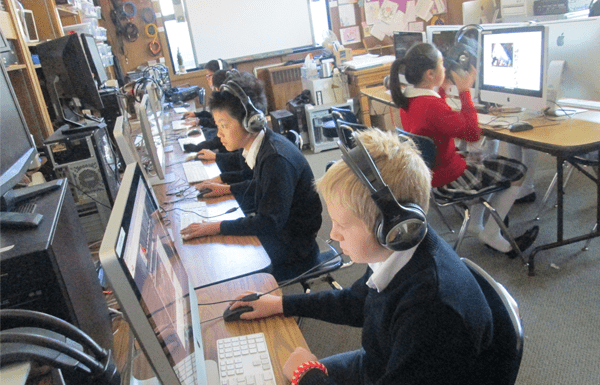
The Illinois Alliance of Essential Schools has linked all its members into a powerful computer-conferencing project called PSInet (People Sharing Information Network). Over 4,000 calls came in last year to the project’s toll-free number, as teachers and students communicated with each other, with school coaches, with the state board of education, with the University of Illinois, and with consultants and on-line technical experts. The network also serves as a gateway to the Internet, the worldwide electronic information highway offering virtually unlimited educational and research uses.
The Coalition’s National ReLearning Faculty maintain close e-mail connections with each other and CES’s central offices in Providence, Rhode Island through a simple and powerful server called CES Online. Some 300 people currently use the network, which is available through an e-mail system that has Internet access. Several dozen Coalition teachers are also communicating electronically with colleagues in Harvard University’s Project Zero and in the Foxfire project, through a server established under the auspices of NCREST, Columbia University’s center for school restructuring. And dozens of interest groups are talking via local electronic bulletin boards in networks like K12Net, the National Science Foundation FrEdMail, the National Education Association’s School Renewal Network, and AT&T’s Long Distance Learning Network.
An interesting example of electronic teacher talk is the Swarthmore Geometry Project, an Internet “hub” with seven news groups devoted to discussing geometry from the school level right up through world-class theoreticians. Math teachers can download articles and book reviews, public-domain software and demonstrations of popular geometry programs, and much more; and they can share assignments and seek advice on teaching dilemmas.
“We had one instance where an internationally known Princeton mathematician queried a high school geometry class on their solution to a geometry problem,” says project coordinator Annie Fetter. “This is a simple and nonthreatening way to cross the thick black line between university and high school.” Citing a Roper poll that found 95 percent of biology teachers felt isolated from their professional colleagues, the biotechnology firm Genentech also recently launched a national computer network to link them with each other and with working scientists.
Enriching professional development programs at schools around the country is the aim of Thayer High School’s monthly hour-long interactive television workshop, “Here, Thayer, and Everywhere,” which is produced by teachers, parents, and students from a crowded control room that abuts the school’s small library. The program goes out to anyone who has satellite access, and scores of schools tune in to watch (or tape for later use) video examples of authentic assessment, heterogeneous grouping, changing math teaching practices, and a range of Essential School ideas.
The program, which reaches groups in 42 states, builds in time for small group discussion and invites call-in questions by phone or fax; it is followed immediately by a related program called MathWatch, which is designed specifically for math educators.
The Implications
As the technological choices get bigger, broader, more mind- boggling, and more user-friendly, how likely is it that Essential schools can and will do much about it? A new poll by Quality Education Data shows the percentage of districts planning to spend more on computer hardware and software in the coming year is at its highest level in five years. But even teachers who already feel comfortable with computers and whose schools enjoy a significant technological presence experience real barriers to integrating computers into their teaching, according to recent research from the Center for Technology in Education.
Those barriers have much in common, moreover, with the typical sticking points around Essential School change in general: time to prepare new kinds of lessons; time for the classes themselves to experience meaningful work; people to coach students in using new tools and practices; and financial support from the school and district, both for professional development and for buying high-tech materials.
On-site support from colleagues and visits to exemplary schools proved a key element for successful teachers in the Center’s study; so was the teachers’ willingness to learn and change, which for some took some time to develop. Even with the best of intentions, meaningful change in this area will take at least five years, the study concludes; and it will depend on teachers having ample computers, support, and time, as well as a school structure and culture that encourages professional experimentation.
Many schools have jump-started their ventures into technology by making partnerships with the private sector; whether for purely civic- minded or for practical marketing purposes, companies from IBM and AT&T to Microsoft and Apple have sunk substantial money and equipment into public education. But there’s a danger in relying on grants or corporate initiatives for what districts should consider as basic as chalkboards and file cabinets, David Niguidula warns.
“Technology acquisition, maintenance, and training should show up as a consistent and substantial line-item in school budgets,” he asserts. As for the discouraging rate at which new systems become obsolete, he says, if schools tailor their purchases to students’ learning needs, then new high-tech purchases (like new textbooks) should only happen when those learning needs require them.
Finally, as Deborah Meier has pointed out, no amount of technology can substitute for the essential ingredient of teaching and learning: wisdom. Indeed, the very notion of what it means to be educated may shift in an era when “memory” applies more readily to machines than to human beings. In this view, only by grounding themselves in a commitment to deeper, more meaningful student engagement will school people succeed in keeping their balance as the information age careens around the corner.